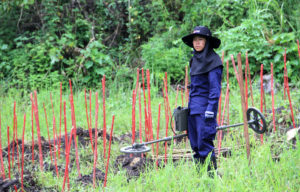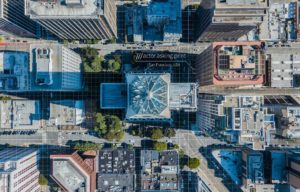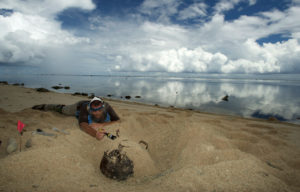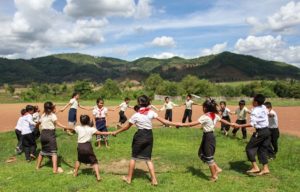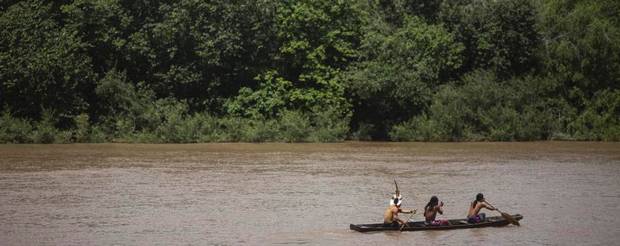
Photo: Felipe Dana / AP
Drones Save Rain Forest
Drones are the newest weapon in the fight to save the rain forest.
Share
The article was published in Jyllands-Posten 29 January 2014.
Other categories
Region: Latin America
Theme: Climate, New Technology, Technology
The forest is still disappearing, but in many places the deforestation catastrophe is being curbed. Compared to 2004, just half the amount of rain forest in the Amazons is being cut and in Costa Rica they have doubled the area of forest since 1980.
The drone looks like an overgrown plaything. Lian Pin Koh, who is an ecologist, tosses it in the air onto its mission.
‘Now we will go grab ourselves a cup of coffee. Or panic the next few minutes worrying that the drone will not return’,he says, when his invention is out of sight.
For the next 30 minutes the unmanned mini flying machine will circle above the rain forest here in Gunung Leuser National Park in Northern Sumatra, and follow the pre-programmed route that Lian Pin Koh and the other biologists have mapped out. The route covers an area of about 30 square kilometres, and to create an overview of an area this size on foot and from a helicopter would cost many hours and up to 1.5 million Danish kroner. The drone does not cost more than a laptop; unrestricted by the tough terrain below and the skies above it hovers over the forest on the lookout for orangoutangs. The drone returns intact and as soon as the machine has landed, the biologists devour it to get hold of the detailed photographs of the area that it has brought back.
Gunung Leuser is one of several places in the world where drones, usually associated with the war against terror, are used as a technology that does not take life, but instead helps preserve it. Lian Pin Koh’s eco-drones are not armed with anything more than a camera, and its most important task is to collect data about the conditions of both forest and animals and discover threats to the rain forest like illegal logging or poaching.
90% of all logging is illegal
Often the laws that are created to protect the rain forests are being violated. Close to 90% of all logging in the rain forest today is illegal. The drones, both cheaper and more secure to send out than watchmen, are therefore a great help to the local communities that live in and off the forest but lack the resources to protect it. With pictures from the drone, poachers and illegal logging can be reported to the authorities.
The drones illustrate how the fight for the world’s rain forests is ongoing. But they are also an example of how this fight has resulted in surprising solutions. Solutions that actually work, since the biological catastrophe that was predicted has, if not been averted, then slowed down dramatically in many countries.
That the effort is working can be seen in the Amazons, where just half the area of rain forest is now being cut down compared to 2004. Or in Costa Rica, where there is now twice as much forest than in 1980.
Still big challenges
Political initiatives have been a factor in Costa Rica, where financial incentives to preserve rain forest have been implemented. However according to an analysis from the World bank, ‘Costa Rica: Forest Strategy and The Evolution of Land Use’, it is a combination of public and private initiatives, including NGO projects, that have prevented an ecological catastrophe.
But there are still challenges. It has taken 60-100 million years for the complex network of interdependent species to evolve in the rain forest. On the contrary it has only taken around 50 years to reduce them by half. Since 1950, the acreage of the original rain forest has dwindled from 15 to 6 million square kilometres. Today, an area double the size of Denmark is disappearing every year, equivalent to a football field every second.
The rain forest is cleared to make way for agriculture, especially plantations and grazing for livestock, for mineral extraction, or for roads and other infrastructures. Unfortunately, the outcome for agriculture is rarely very favourable: the soil underneath the rain forest is often short in nutrients because undamaged forest saves the nutrition in the living plants. But because of poverty in many of the rain forest countries and because the forest in itself does not generate much profit, the local forest owners often have no alternatives but to sell to large companies or to cut down the forest and cultivate the land in the short time this is possible. All in all, the rain forest is continuously disappearing – rapidly, and to a great extent.
This is in every way a huge loss, and not only to the some 50 million people who are dependent on the forest. The rain forest binds huge amounts of CO2, and hence deforestation is already by now causing more climate changes than all the cars in the world combined. Furthermore, the extreme diversity of species makes the rain forest our genetic futurology.
Actually one quarter of all western medicine in use today stems from the rain forest. And yet we only know the medical effect of approximately 1 per cent of the plants in the rain forest.
Ecotourism, a new occupation
Experience shows that the efficient solutions are the ones that do not treat clearcutting as a rain forest issue, but as a social problem. Poverty and deforestation are two sides of the same coin. The key to preserving the forest is thus to create new alternative ways to earn a living for the people living in and off the forest.
This alternative could be ecotourism. In this respect, Costa Rica is once again the top boy. The country has built its brand, and an industry, around rain forest tourism, helped along by NGOs. Since the 1980s ,the number of tourists in the country has grown from 300,000 to 2 million and thus the rain forest has become an important source of income – a development more countries are now trying to imitate.
Another alternative source of income is agriculture that does not require deforestation: coffee and cacao can for instance easily be cultivated in the rain forest shade. Or a careful and sustainable forestry ensured through certification like FSC (Forest Stewardship Council).
Finally, it can also be a matter of giving the legal rights of the forest to the indigenous people who have lived in the rain forest in a sustainable way for thousands of years.
And then at times it can also be about finding creative solutions to the more practical issues, like using eco-drones. This is not a magic fix that will safeguard the rain forest alone, but they are promising new devices that will make it easier to accomplish the required changes.

